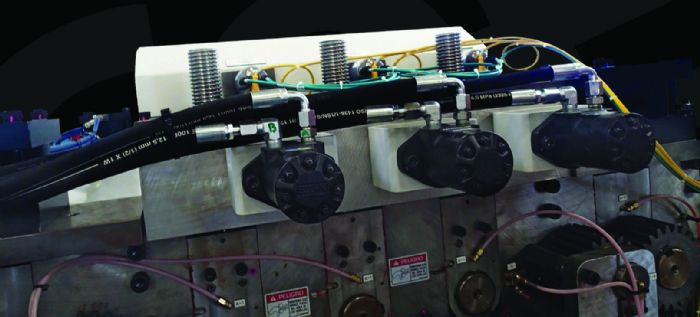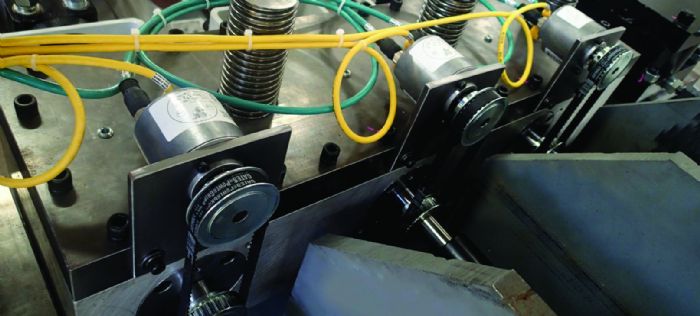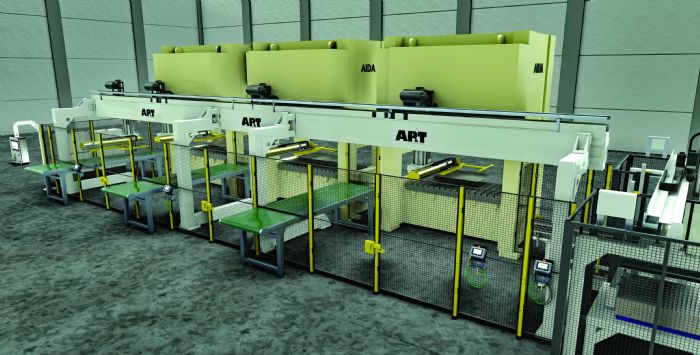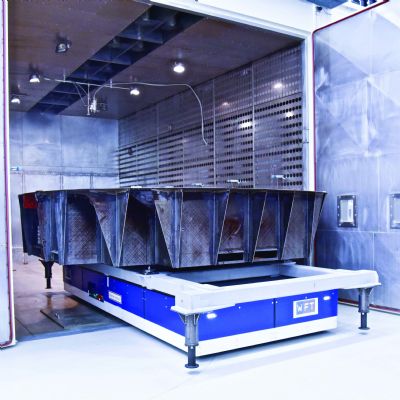“Although it might not always appear that automated lines run more quickly than manually tended lines,” Wenzel says, “we know that while operators often can hand-transfer parts very quickly (while a manager stands by with a stopwatch, for example), they can do so only for a limited time. Eventually they slow down, and throughput becomes erratic. This, compared to automation which just runs and runs, continuously at the same speed and without pause.”
Therefore, Wenzel stresses that stampers, when evaluating the potential return on investment of process automation, not only evaluate potential improvements in stroke rate, but also focus on total shift throughput.
“We typically see total throughput increase by 30 to 60 percent or more,” Wenzel says, “due not only to increased press stroke rate but to gains in process stability and improved quality. Uptime percentage is very high with automation and plays a key role in increasing output.”
Supporting Wenzel’s ideals, a blog post from the automation experts at Toronto-based Blueprint notes that “the standard average of automation uptime we’ve observed is 92 percent.”
Note: The post goes on to say that while automation should run close to 100-percent on time, it often does not due to a lack of proper maintenance. It also stresses the need for manufacturers to leverage real-time data collection and analysis, dashboards, and analytics to deliver the data and information required to enable the predictive and preventive maintenance that keep automated lines running at their best.
Uptime Beats Stroke Rate
What can metal formers expect during their automation journeys? What are the common hurdles along the way?
“I find that expectations always hover lower than reality,” Wenzel notes. “We can calculate the expected improvement in strokes/min., for example, but it’s hard for clients to really trust the gained uptime by automating a press line compared to running it manually until they see it. Stampers often underestimate what the uptime will be with the automation, and overestimate what they believe the uptime is manually.
 “I have a client,” Wenzel offers as an example, “whose automated press line actually experienced a reduction in strokes/min., yet shift throughput climbed significantly. Why? Because uptime beats stroke rate. When evaluating the potential ROI of automation,” he stresses, “do not underestimate the amount of downtime that actually occurs on a manually tended press line.”
“I have a client,” Wenzel offers as an example, “whose automated press line actually experienced a reduction in strokes/min., yet shift throughput climbed significantly. Why? Because uptime beats stroke rate. When evaluating the potential ROI of automation,” he stresses, “do not underestimate the amount of downtime that actually occurs on a manually tended press line.”
 Don’t forget, too, Wenzel adds, the potential to damage parts when hand-transferring them, whether along a press line or during end-of-line operations. “I’ve seen manually tended lines where stampers experience a significant number of damaged, highly cosmetic parts from manual handling,” he shares. “Damaged parts represent lost revenue and wasted production time. Quality levels often can jump when adding automation to production lines.”
Don’t forget, too, Wenzel adds, the potential to damage parts when hand-transferring them, whether along a press line or during end-of-line operations. “I’ve seen manually tended lines where stampers experience a significant number of damaged, highly cosmetic parts from manual handling,” he shares. “Damaged parts represent lost revenue and wasted production time. Quality levels often can jump when adding automation to production lines.”
Case Study—Automating Hand-Transfer
“One of our clients,” Wenzel continues, “an OEM manufacturer of consumer goods, recently reported significant gains from automating a hand-transfer line where multiple operators moved parts through multiple presses. First, a great deal of work in process (WIP) accumulated between each tool/press. The first stage was coil-fed, the remaining all hand-transfer, and output averaged 200 parts/hr. We added a larger-bed press and automation to the line, while continuing to coil-feed the first die station. The automation eliminated WIP and output doubled to 400 parts/hr. And, when stamping smaller parts, the company retooled the line to stamp two out per stroke, so that output rose from 200 to 800 parts/hr.
“In addition, he continues, “while the reduction in manual labor due to the automation varies by job, on average we helped this customer reduce the amount of labor related to material handling by 80 percent. We also eliminated lost production caused by the scrapping of cosmetically sensitive parts that experienced scratches and dents during hand feeding. This allows the manufacturer to now sell—for profit—thousands of parts per year that otherwise would have been scrapped.”
While automation obviously allows a manufacturer to do more with less, “let’s not forget that even where stampers can find operators, often we find that employees are aging out,” Wenzel says. “We’re often automating rigorous, strenuous manual tasks, which allows a company to then reassign older yet knowledgeable and experienced operators to other less-strenuous roles, extending their working life.
“Don’t underestimate the safety and ergonomics benefits to automating,” he adds.
What are the Hurdles
…to implementing part-feed automation? “When you’re trying to add automation to presses running tooling not originally designed for automation,” Wenzel says, “often the parts must transfer at varying heights above the bolster for some die stations. While a simple chore for an operator, automation setups ideally require that part load and unload simultaneously occur at all die stations. Unless the stamper can adjust and modify the tooling, the automation must emulate an operator’s moves, limiting its operating speed.”
Other concerns:
- Scrap must shed automatically, or be capable of being picked up and removed by the automation.
- The part should be lifted by the tooling in the upstroke to make it easier to grip and lift, saving cycle time.
- Where possible on existing and on all new tooling, remove anything in path of the automation to allow shorter, faster movements. This may require, for example, moving tool guideposts.
- The tooling must provide “nesting” guidance for the part so that it can be released and then located precisely as it drops into the tool.
Also be aware, Wenzel says, that part-transfer automation is sensitive to the location of the die in the press. With manually tended press lines, the die need not be precisely and repeatedly located in the press from run to run; the operators can adjust. However, automation requires precise, repeatable die locating every time a job runs. This typically requires stampers to modify the tooling by adding some sort of die-locating mechanism.
“We also see the need to upgrade press controls in some cases,” Wenzel adds. “Stampers with older controls on their presses may find them unsuitable for integration to automation. Confer with your automation supplier regarding the required I/O and functions to learn if your press controls are up to the task.
“And, think about the guarding when adding automation,” he continues. “Automation brings safeguarding concerns beyond those related to the point of operation; you also must guard the automation itself because it moves and can cause injury. Additionally, the automation moves stamped parts potentially weighing dozens if not hundreds of pounds, quickly in and out of the press, and sometimes from press to press separated by potentially 40 or more feet. The automation losing control of the part mid-move creates another hazard.
“What metal formers sometimes miss in their initial layout work,” Wenzel adds, “is that often the automation will require fencing well out from the press(es) to encapsulate the fast-moving automation and the parts being carried. It’s important to thoroughly understand the OSHA and ANSI guarding standards that must be followed when adding automation.”
Where Else Can Metal Formers Automate?
While material-handling automation will increase throughput, let’s not forget automation designed to speed equipment setup and minimize changeover time, improving overall equipment effectiveness (OEE). Here we’re talking about automated adjustments included with each job recipe—press shut height, feed-line parameters, cushion pressure and more. These adjustments, not long ago, typically required an operator’s attention—turning a hand crank for example.
While stampers can retrofit, in some cases, their existing mechanical presses with automated setup features, when it comes to coil lines, Wenzel explains, in nearly every case stampers opt to purchase a new, state-of-the-art line with these automated setup features. “Here,” he says, “we follow the ‘Missouri test’—show me. We’ll replace one aging coil line in the plant with a new one to prove out the results, to then help justify further investments.”
Yet another setup function often automated: die clamping. Traditionally operators turn wrenches on bolts to clamp and unclamp dies, which takes time and can be a safety concern.
“Now we see magnetic clamping that can clamp an entire die in 20 sec., maybe less,” Wenzel says, “compared to 5 min. or more manually.”
Robots/Cobots on the Move
Finally, metal formers have begun to add robots and cobots to their operations at an accelerated pace. Just be sure to select the right solution for the job, Wenzel warns.
“One aspect of cobots that people might overlook when trying to automate a press,” he says: “Cobots are great because you do not need to guard the cobot itself, but don’t forget that you still need to guard the press. On many press controls, if you put a light curtain around the point of operation and then pass through the light with the automation, the machine will drop out of automatic mode. This requires that an operator hit a ‘prior action’ button to arm the system.
“Such a setup will not work with an automated system,” Wenzel continues. “In these instances, the robot will need to be inside of a guard protecting both the automation and the press. So, if the robot must be inside of the guard anyway, it often is more productive to run a faster industrial robot than the slower moving cobot.”
Robot Mode
Some newer press controls have a “robot mode” setting for automatic single-stroke mode—created specifically for automated press tending. “If the press is stopped at top, you can penetrate the light curtain, then leave,” Wenzel explains, “and the press will remain in automatic mode. In these cases, a cobot would be fine. But because many controls do not have this feature, stampers should investigate how their press control will react when automation passes through the guarding.”
One press control with this newer robot mode: Link Systems’ OmniLink 5100. “The Type 3-Robot Mode in the Link controls,” explains James Barrett, president of Link Systems, “is an automatic single-stroke setting that allows a robot, transfer system or other automation device to not only pass through a light curtain (configured to be muted in the upstroke) on the upstroke in the process of starting the transfer, but to also finish the transfer with the press stopped at the top of the stroke, where the light curtain may no longer be muted, provided that the automatic single-stroke run signal is still low—without disarming the mode. If the light curtain remains interrupted when the ‘go’ signal is received, not only will the press not stroke, but automatic single-stroke is disarmed, and an operator must press the prior action button and hit the palm buttons to re-arm the mode after the light curtain is cleared and all other running conditions have been satisfied.
“This most often is used in heavily automated operations,” Barrett adds, “often in a line of presses with robotic transfers between or within the presses. For instance, we see this with large or ungainly appliance or automotive parts that might be roll- or blank-fed into the first press in a line and then undergo further operations on additional presses and/or other machines, where the best way to transfer the parts among machines is with special manipulators. Another typical application: a transfer system that must reach in past a light curtain used for operator protection during setup or troubleshooting operations, when the nature of the die or process results in the press having to stop at top to complete the transfer. This Robot Mode of control can eliminate the need for complex logic and/or interlocks to disable the curtains during automatic operation.
“We have a long history of working with complex automation,” Barrett concludes, “including integrations with transfer systems that let our control signal a transfer system that the press has been requested to run, letting the transfer move from a parked to ready position, and then allowing it to signal the control to actually initiate the stroke. We also have functions that allow us to work effectively in concert with safety PLCs that coordinate an entire line for fully automatic job changeover as well as line operation. While some of these functions can be accomplished using external equipment, that can increase the cost and complexity of the final solution while greatly reducing diagnostic clarity.” MF
View Glossary of Metalforming Terms
See also: Link Systems, AP&T North America Inc., TCR-Integrated Stamping Systems
Technologies: Pressroom Automation
Comments
Must be logged in to post a comment. Sign in or Create an Account
There are no comments posted. Pressroom Automation
Pressroom AutomationVideo Showcases Audi Q5 Production in Puebla
Thursday, March 20, 2025
 Video
Video  Pressroom Automation
Pressroom AutomationAtlas Technologies Celebrates Turning 60
Tuesday, March 11, 2025







 Now, however, as we all know too well, with fewer people in the workplace it’s becoming more urgent to automate lower-volume production. Fortunately, where in the past the math didn’t work, modern automation has become less costly and more flexible, and easier to justify for lower-volume jobs. So says Todd Wenzel, owner/president of TCR Integrated Stamping Systems, Wisconsin Rapids, WI, a turnkey provider and systems integrator—whether a metal former needs to improve existing equipment or requires an entirely new production system.
Now, however, as we all know too well, with fewer people in the workplace it’s becoming more urgent to automate lower-volume production. Fortunately, where in the past the math didn’t work, modern automation has become less costly and more flexible, and easier to justify for lower-volume jobs. So says Todd Wenzel, owner/president of TCR Integrated Stamping Systems, Wisconsin Rapids, WI, a turnkey provider and systems integrator—whether a metal former needs to improve existing equipment or requires an entirely new production system. 